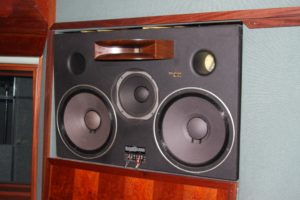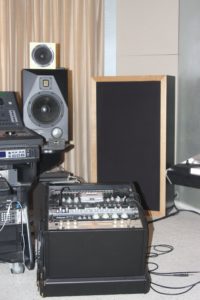Speakers Are Miniature Rooms
Our speakers look like miniature rooms. They have side walls, a “floor” and “ceiling”, and the end walls to support everything. Their construction is probably stronger than most of the rooms I see. Most speakers have internal bracing mechanisms that keep the walls of the cabinet from vibrating. They hold lots of sound energy and the pressure that goes with all of that energy. When you really think about it speakers are a small room with similar acoustical issues that must be dealt with in order to produce quality sound.
Small Room Acoustics
The internal volume of our speaker cabinet is much smaller than the smallest room we would ever play music in. With this smaller volume, we have pressure issues that must be dealt with. Lets take a simple two way speaker. The lower frequency driver moves back and forth in a piston like movement in response to the electrical current that is applied to it. This driver diaphragm movement creates a pressure wave inside the cabinet just like our speakers produce a pressure wave inside our rooms.
Pressure, Pressure, Pressure
This pressure enters the room or speaker cabinet and immediately tries to escape. Lower frequency wavelengths will actually pass through the cabinet walls just like in our home theater, listening rooms or professional recording studios. This pressure builds up at the inside of the speaker’s walls. It reacts to the dimensions within the speaker’s cabinet just like our room dimensions to produce cabinet modes.
Resonances
Just like in our rooms, the pressure build up at all the speakers boundary intersections. The intersections of all the speaker’s boundaries are just like the intersections of our room surfaces. Energy accumulates at these intersections and activates the room or cabinet modes that are associated with the inside dimensions of the cabinet. These resonances are just as unwanted inside the speaker cabinet as they are in our rooms.
Resonances Confuse
Resonances inside the speaker cabinet behave the same way they do within our rooms. If the resonances are strong, they can overpower the other sound energy that is within the speaker cabinet and produce another sound that will travel out the driver and into our rooms. We will then have the sound of the driver coming out of the speaker cabinet and also the “sound” of the resonances from within the speaker cabinet. I can imagine that no speaker designer would want those two energies competing against each other.
Resonances Smother
Resonances inside our listening rooms, home theaters, and professional recording studios can blur or smear certain frequencies and also can completely cover up others. Modes in our listening rooms, especially the lower frequency ones, can smother all other frequencies present in that area of our room. They are like a black hole in space. Whatever goes in does not come out at least in the dimensions of time and space as we know it. If you place a microphone within a room mode, you may not be able to record any of the energy because the room mode is covering all other weaker frequencies up with its excessive pressure.
Reflections
Reflections from our room boundary surfaces intermix with the the direct energy from our speakers. This blend of direct and reflected energy determines what sound qualities we will have at the listening position. We will have the direct energy that travels in a straight line from the speakers to our ears and we will also have the reflected energy or “room sound”. In a speaker cabinet internal cabinet reflections are a concern if they can get close to achieving audibility.
Sound Absorption Technology
To manage and control both reflections inside our speaker cabinet and also inside our rooms, we turn to sound absorption technology. We have sound absorbing acoustical foam which is a popular treatment for inside our speaker cabinet. It is also a popular acoustical treatment in small and large room environments. Some would say a little too popular. Manufacturers of foam technology would have you believe that foam is the answer to everything. It is lightweight and relatively economical to produce and would work well inside a speaker cabinet. It works well inside of small rooms, if one can match the foam absorption curve with the needs of your particular room. Not all foam works well in all rooms.
Foam Is First Choice
Foam may work well inside some speaker cabinets, but what about all the room or cabinet modal pressures that exist at lower frequencies. In a sub woofer cabinet, we are dealing with larger drivers and larger pressure levels. Foam may not help us in lower the pressure levels to the level of inaudibility required by the speaker designer. For this heavy lifting, we can turn to a natural substance called activated carbon or charcoal.
Activated Carbon
Activated carbon or charcoal looks like a miniature meteor. It has a series of pores or holes that allow for sound energy to enter, move around a little, and be converted to heat. Pound for pound, it is a very powerful absorber.To determine how much and where to position the activated carbon will be the task of the speaker designer. A good start would be the rear cabinet wall, directly behind the driver. A good start for lower frequency absorption is the areas closest to the speakers in our listening rooms, home theaters, or professional recording studios.
Speakers Are Rooms
Speakers are miniature rooms with the same resonance and reflection issues that plague our small room acoustic environments. Low frequency energy inside our speaker cabinets produce “room” modes that can reach levels of audibility in both our rooms and speakers. Acoustic foam and even charcoal can be used as sound absorption technology to deal with the acoustic issues present in our speakers and rooms.









We use broadband absorption in the two most critical frequency regions in small rooms. Our Diaphragmatic absorbers, ACDA series, have…
Interesting web site and provocative introduction. Please check your copy for typos, otherwise nicely presented. I would like to see…
There is no such thing as soundproof anything especially carpet. Low frequency noise transmission requires a permanent construction fix with…
Hello Dennis! Our neighbors put a Ice Bath in their garage which is right below our bedroom and the Low…